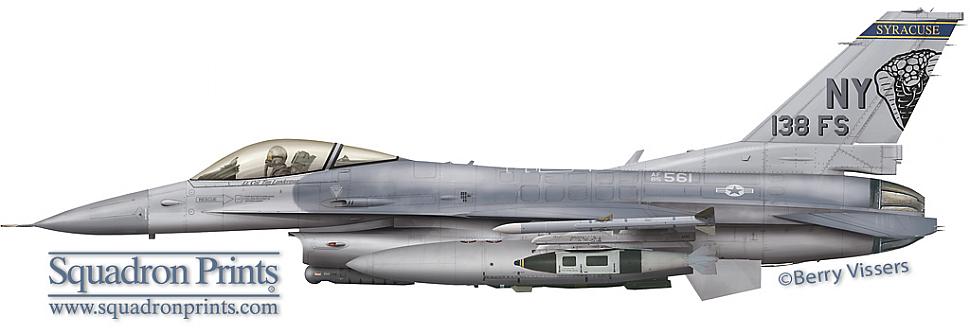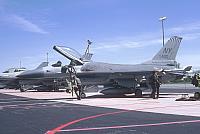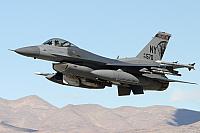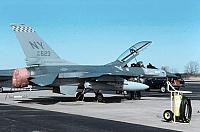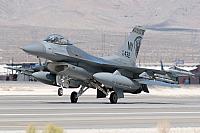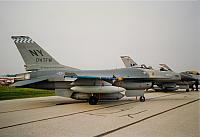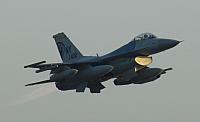 |
138th Fighter Squadron ( USAF ANG)" Cobras" |
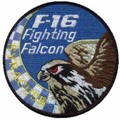 |
138 FS " Cobras" ( USAF ANG) | |||
| Status: |
Converted
|
|||
| Version: | F-16C/D block 30 (small mouth) | |||
| Role: | Air Defence, Attack | |||
| Tailband: | Dark blue & Yellow | |||
| Motto: | The Boys From Syracuse. | |||
| Badge: | N/A | |||
|
Converted to the MQ-9 on February 20th, 2010.
|
||||
F-16 History
In 1989 the 138th FS began transitioning from the A-10A to the F-16A/B block 10, although the first airframes started arriving in late 1988. These aircraft were passed down from regular USAF units who were upgrading to the C/D model of the Viper. During 1989 IOC was reached and the unit – being equipped with the block 10 type – was chosen as a test unit for a close air support version of the F-16 (dubbed F/A-16). These airframes were equipped with the General Electric GPU-5/A Pave Claw pod on the centerline station. The pod housed a 30mm GAU-13/A four-barrel derivative of the seven-barrel GAU-8/A cannon used by the A-10A, and 353 rounds of ammunition. The aircraft were the only F-16s ever to be equipped with this weapon, intended for use against a variety of battlefield targets, including armor.
In this configuration the squadron was deployed to the Persian Gulf for Operation Desert Storm. The project however proved to be a miserable failure. Precision aiming was impossible for several reasons: the pylon mount wasn't as steady as the A-10's rigid mounting; the F-16 flies much faster than an A-10, giving the pilots too little time approaching the target; firing the gun shook the aircraft harshly and made it impossible to control; essential CCIP (continuously computed impact point) software was unavailable. The pilots ended up using the gun as an area effect weapon, spraying multiple targets with ammunition, producing an effect rather like a cluster bomb. It took only a couple of days of this before they gave up, unbolted the gun pods, and went back to dropping real cluster bombs - which did the job more effectively. The unit received the Air Force Outstanding Unit Award, with the ‘V’ device for valor, during Operation Desert Storm; the Air Force Association Outstanding Unit Award and the National Guard Association's Best Family Support Center Award.
In 1993 the squadron started trading in their old block 10 models for newer block 30 models. In that process the squadron had the ‘honor’ of sending the first F-16 airframe to AMARC aka ‘The Boneyard.’ This happened on July 20th, 1993 when an F-16A (#79-0340) was flown into the desert for flyable storage. Although these airframes were only 13 years old, they were put into storage due to more modern models becoming available and these blocks weren’t needed any longer by the USAF. The general mission for the squadron remained unchanged with this transition. Only six years later – in 1999 – the 138th FS changed block types once more, with the introduction of older block 25’s. This meant changing again from the General Electric engine to the Pratt & Whitney. As if this wasn’t enough, the squadron return back to the block 30 airframes in 2004, shifting from engine type once more.
In 2008 it became apparent that the 138th FS was going to loose its airframes and that Hancock ANGB would lose its manned aviation after more than 60 years of operations. The squadron was set to fly the MQ-9 Reaper unmanned aerial vehicle (UAV). On March 6th, 2010 the last two F-16s (#85-1561 and #85-1570) departed Hancock Field marking the end of F-16 operations at the base. They made three low passes for the assembled crowd gathered to commemorate the end of manned aviation at the Syracuse ANG base in upstate New York.
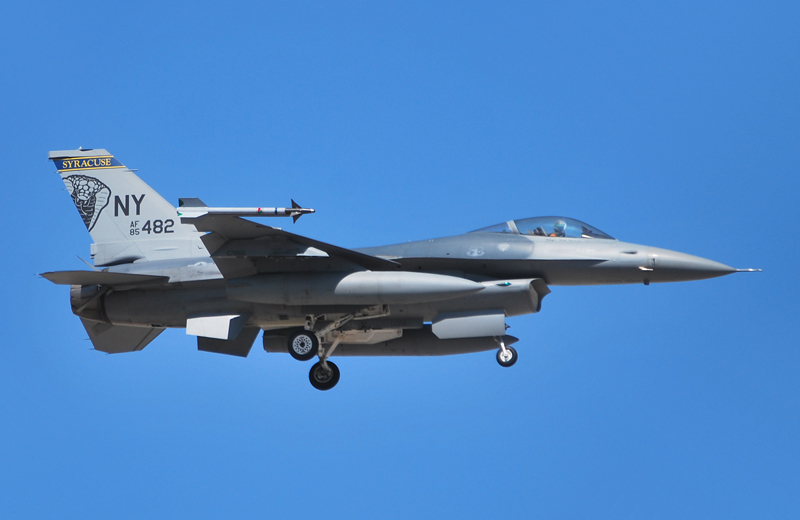
Aircraft Markings History
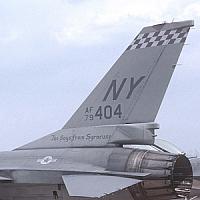
The tail consisted of a white and grey checkered tailband with the tailcode 'NY' in the center of the tail and the serial underneath it. On the tail base the 'The Boys From Syracuse' titles could be found. These markings were also in place with the introduction of the block 30 airframes.
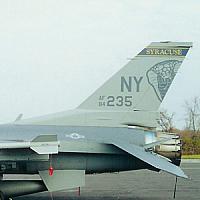
With the introduction of the block 25 airframes, the tail scheme changed completely. The tailband changed to dark blue with yellow stenciling and 'Syracuse' titles in the tailband. The 'NY' tailcode and the serial number were retained, but on the rudder a large cobra snake appeared. This scheme was retained with the re-introduction of block 30 airframes.
Unit History
- 1942: Activation of the squadron in Hunter, Georgia (as 484 BS)
- 1942: A-24 'Dauntless' (part of 339 BG)
- 1943: A-24 'Dauntless' (Drew Field, Florida)
- 1943: A-24 'Dauntless' (Walterboro Field, South Carolina)
- 1943: P-39 'Airacobra' (as 505 FS, Rice Field, California)
- 1944: P-51 'Mustang' (part of 339 FG, Fowlmere [Eng.])
- 1945: P-51 'Mustang' (Camp Kilmer, New York)
- 1945: Deactivated
- 1946: Activation of the squadron in Hancock, New York (as 138 FS)
- 1946: P-47D 'Thunderbolt' (part of 174 FG)
- 1950: F-51H 'Mustang'
- 1950: F-84B 'Thunderjet'
- 1954: F-94A/B 'Starfire'
- 1957: F-86H 'Sabre' (part of 174 FIW)
- 1962: F-86H 'Sabre' (part of 102 TFW, Phalsbourg AB [Fr.])
- 1962: F-86H 'Sabre' (part of 174 TFG, Hancock AB, New York)
- 1970: A-37B 'Dragonfly'
- 1979: A-10A 'Thunderbolt II' (part of 174 TFW)
- 1989: F-16A/B 'Fighting Falcon'
- 1992: F-16A/B 'Fighting Falcon' (part of 174 FW)
- 1993: F-16C/D 'Fighting Falcon'
- 2010: Converted
Deployments
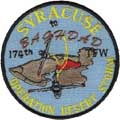 |
' Desert Storm' |
| Alkharj AB, Saudi Arabia (November of 1990 to March of 1991) | |
| Desert Storm was initiated to attack Iraqi forces that had invaded Kuwait. The 138th TFS deployed completely and was the sole unit to employ their block 10 airframes in the CAS role with a GAU-5 gun. This test wasn't successful and the unit transitioned to traditional bombing with Mk. 82 bombs instead. | |
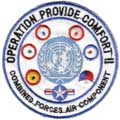 |
' Provide Comfort II' |
| Incirlik AB, Turkey (May of 1995 to September of 1995) | |
| This operation was set to protect the Kurds in the north of Iraq. In total these deployments lasted for a mere 12 years ending with the regime of Sadam Hussain being overthrown. | |
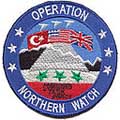 |
' Northern Watch' |
| Incirlik AB, Turkey (August of 1996 to November of 1996) | |
| Operation Northern Watch was a US European Command Combined Task Force (CTF) who was responsible for enforcing the United Nations mandated no-fly zone above the 36th parallel in Iraq. This mission was a successor to Operation Provide Comfort which also entailed support for the Iraqi Kurds. | |
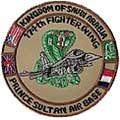 |
' Southern Watch' |
| Prince Sultan AB, Saudi Arabia (February of 2000 to April of 2000) | |
| Operation Southern Watch was an operation which was responsible for enforcing the United Nations mandated no-fly zone below the 32nd parallel in Iraq. This mission was initiated mainly to cover for attacks of Iraqi forces on the Iraqi Shi’ite Muslims. | |
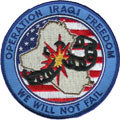 |
' Iraqi Freedom' |
| Balad AB, Iraq (November of 2003 to February of 2004) | |
| This marked the first deployment of the squadron into the Middle East to endure the no-flying zone over Iraq and secure the ground forces safety. | |
 |
' Iraqi Freedom' |
| Balad AB, Iraq (September of 2006 to December of 2006) | |
| This was a rainbow deployment with F-16s from the 107th, 121st and 175th FS in the AEF 3/4 cycle. | |
 |
' Iraqi Freedom' |
| Balad AB, Iraq (May 24th, 2008 to September 17th, 2008) | |
| This was a deployment together with the 175th and 119th FS as part of AEF3/4 (Cycle 7). This was also the last deployment of the squadron since its set to convert to the MQ-9 Reaper in 2010. |
F-16 Airframe Inventory
- All 138 FS F-16s in our F-16 Aircraft Database (past and current aircraft)
- Current 138 FS F-16s in our F-16 Aircraft Database
Photos
Please use this form to add any list any error or omissions you find in the above text.
Note: your comments will be displayed immediately on this page. If you wish to send a private comment to the webmasters, please use the Contact Us link.

